
From February 1940 until 1943, a significant number of New Zealand troops were based in Egypt. Initially, they used Egyptian stamps, but from 1 May 1941, British Middle East Forces were able to use the stamps of their own country on letters home.
Egypt to New Zealand before Horseshoe Route
Until 8 March 1940, mail from New Zealand troops was handled by the British Army Post Office, but after that they were handled by the New Zealand Army Base PO [2].
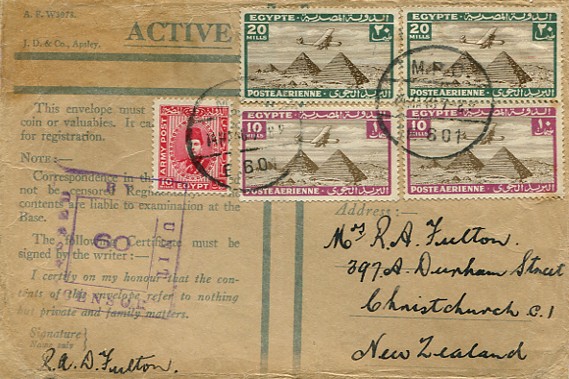
This airmail cover is postmarked M.P.O. E.601 on 14 May 1940 and is franked with Egyptian stamps. The airmail rate to New Zealand was 10 mills per 20 grammes surface with a 30 mills per 10 grammes air mail surcharge [2]. It is franked with 70 mills and so this cover weighed more than 10 grammes.
It should be noted that one of the Egyptian stamps is a special Army Post stamp at least one of which had to be used in the franking. These stamps showing King Farouk were first issued on 12 December 1939 replacing larger stamps showing King Fuad that had first been issued on 1 March 1936 [7].
The cover would have been sent on SE 247 that flew Alexandria - Sydney on 20 - 28 May and then trans Tasman on 30 May.
The cover is a special Active Service Honour envelope which contains the following
declaration that had to be signed by the writer:
I certify on my honour that the contents of this envelope refer to
nothing but private and family matters.
They were guaranteed not to be opened by the Unit Censors and so the senders could write about personal
matters that they did not want known by their immediate superiors.
The letters could be opened by the Base Censors [6].
Egypt to New Zealand after June 1940
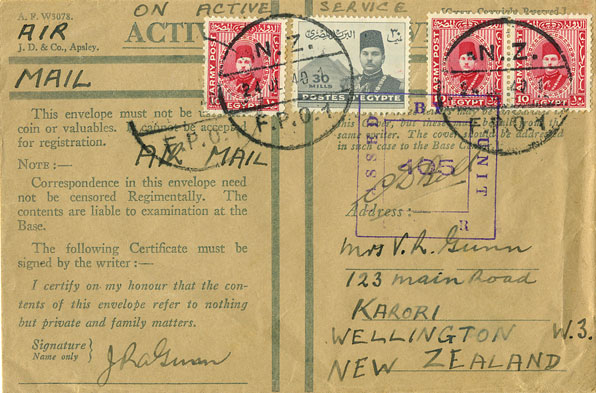
This airmail cover is postmarked 24 July 1940 and so was posted after the start of the Horseshoe Route. The main effect was a reduction in the frequency of the service and in the quantity of mail that could be flown.
The Active Service Honour is franked with 60 mills in Egyptian stamps. As it looks as if one stamp is missing, the original franking was likely 70 mills for more than 10 grammes.
It has a signed Passed by Unit Censor handstamp in purple.
It may have been sent on NE 6
which left Cairo on 27 July and arrived in Sydney on 5 August.
here.
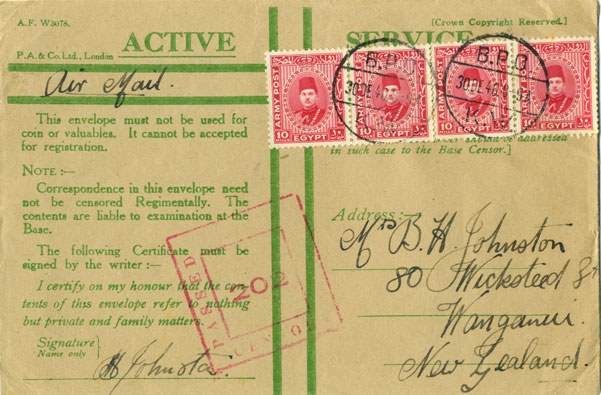
This airmail cover is postmarked 30 December 1940 and is franked with four Army Post Egyptian stamps making up the airmail rate of 40 mills.
The envelopes were initially produced by three different printers and then from 1941 by the Army Printing Service [6]. This special Active Service Honour envelope is printed by P.A. &Co. in a brighter green than the previous one by John Dickenson & Co.
The postmark is BPO (Base Post Office) and KW. This postmark was introduced in September 1940 and was used by the New Zealand Divisional Office in Maadi. In December 1940, the office was moved to Helwan and that is where this letter would have been processed.
Possibly flown on flight NE 47 that left Cairo on 2 January 1941
and arrived in Sydney on 10 January.
There was a Trans-Tasman flight on 12 January.
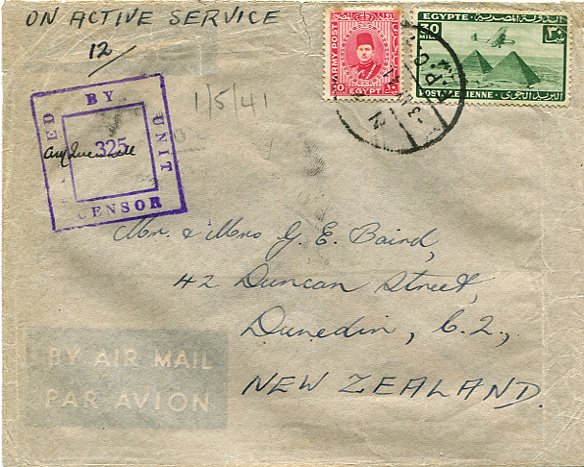
This cover is postmarked F.P.O. 1 on 3 May 1941 and is franked with Egyptian stamps although New Zealand stamps could be used from 1 May.
Due to the Rebellion in Iraq, Lake Habbaniya was not available as a stop and so there was no service between Cairo and Basra after flight NE 81 that left Cairo on 30 April and flight NE 85 that left on 15 May.
The route taken by this cover is therefore not clear, but it may have
either been sent to India by sea and flown from there or have been sent all the way to Australia by sea.
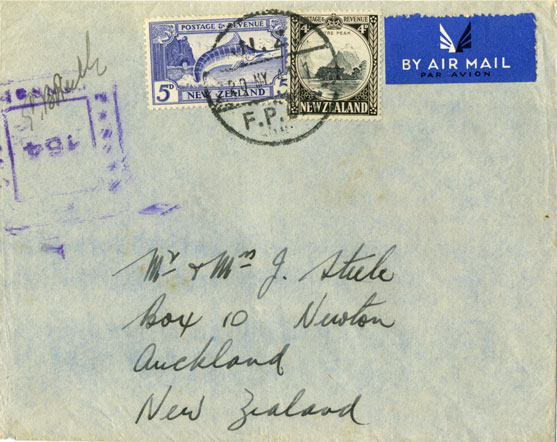
Using New Zealand stamps
From 1 May, 1941, New Zealand stamps could be used on forces mail from Egypt [2]. This next cover is an early use of New Zealand stamps and was sent from Egypt to Auckland. It is postmarked on 20 May 1941 with a Field Post Office postmark inscribed N.Z. F.P.O. 1.
The airmail rate for forces airmail to New Zealand was 9d for the first half ounce and 1/6 for each further half ounce [2].
The signed purple cachet on the left contains the phrase passed by unit censor.
The cover would be sent by the Horseshoe Route to Australia, perhaps on flight NE 88 that left Cairo on 26 May and arrived in Sydney on 4 June [1]. It was then flown to New Zealand by TEAL, perhaps on 6 June.
An article by Leppard illustrates the different postmarks used by New Zealand troops
in the Middle East [3] while an article by Startup describes the requisitions by the NZ
Base Post Office for New Zealand stamps and the stamps that were delivered [5].
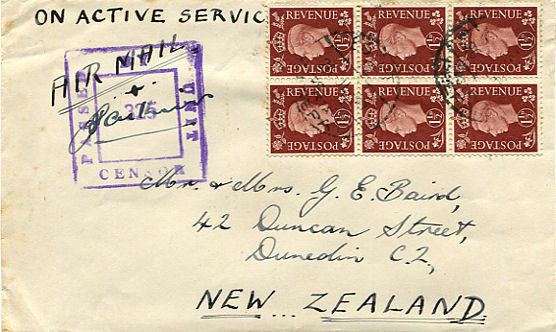
Use of GB stamps
New Zealand troops left Egypt for Greece in March 1941. During the subsequent evacuation from Greece to Crete in April, large stocks of New Zealand stamps were destroyed. British stamps were used on mail to make up the shortfall. New Zealand troops were evacuated from Crete to Egypt in May 1941. A description of the army post office in Greece in March - April 1941 is given in The Mail Coach [4].
This cover is postmarked Egypt 42 Postage Prepaid on 26 July 1941
and is franked with 9d in GB stamps.
Likely flown from Lydda to Singapore by KLM.
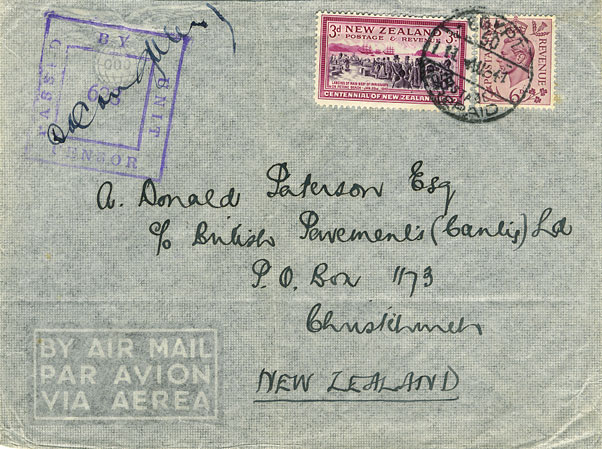
Mixed franking of NZ and GB stamps
This cover is postmarked on 11 August and has a mixed franking of a 3d New Zealand and a 6d UK stamp. Flight NE 111 left Cairo on 13 August and arrived in Sydney on 22 August. However, this cover may have been flown from Lydda to Singapore by KLM.
The Egypt Postage Prepaid postmark had been introduced in April 1941.
The number 50 in this example indicates that it was applied at the Base Post
Office in Ismailia [3].
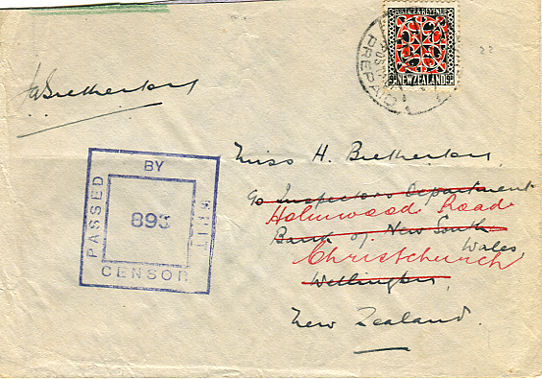
Reserve Route
This cover has an Egypt Postage Prepaid postmark. with number 22 which had been allocated to the No. 1 General Hospital [3].
The date is 11 December 1941 which was after the attack on Pearl Harbor and, due to Japanese advances, the Horseshoe Route was changed. After 8 December, Reserve Route 2 went from Rangoon via Port Blair in the Andaman Islands in the Bay of Bengal to Penang [1].

It was redirected to Christchurch after arrival in Wellington and has a Wellington postmark on 29 December.
It may have been flown on NE 146 which left Cairo on 14 December
and arrived in Sydney on 22 December.
There was a flight to New Zealand before Christmas, but that mail may not
have been delivered until after the Christmas break which explains
why it was not redirected until 29 December.
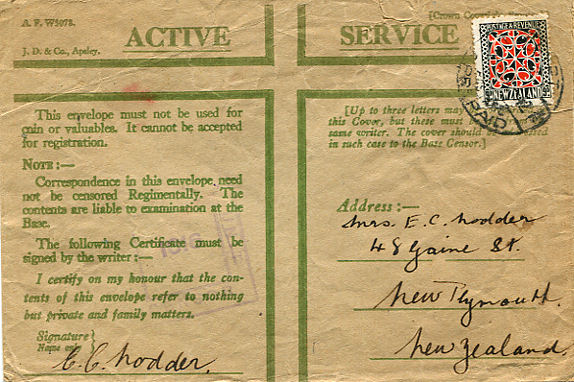
On 23rd January, New Zealand troops in Egypt were warned to restrict their use of air mail and the air mail dispatch from Cairo on 25th January arrived in New Zealand on 19th February [2]. It would have been sent on NE 158 which left Cairo on 26 January and arrived in Sydney on 12 February.
This cover is postmarked in Egypt on 23rd January 1942 and so may have been on that flight.
NE 158 was the first service routed via Tjilatjap and Broome
after Reserve Route 3 was no longer possible.
From Royal Navy Ships

Royal Navy Honour Envelope
As well as the Army Honour envelopes printed in green on buff, there were also Royal Navy and Royal Air Force Honour envelopes.
This example of a Royal Navy Honour envelope is printed in navy blue on buff. It is addressed to New Zealand and postmarked in July 1941. It would have been posted on board ship and then posted when it reached the next port which in this case was in Australia.
The franking is the forces concession rate of 9d, but as it was posted in Australia only 5d would be required for internal Australian air mail services plus the trans Tasman service.
It has the so called Tombstone censor mark that
was introduced in December 1939.
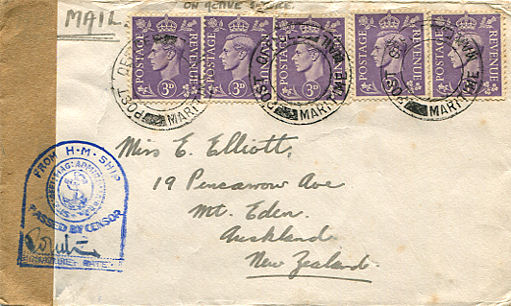
No date
This cover is franked with 1s 3d in British stamps and is addressed to New Zealand. Again it would have been posted aboard a naval ship.
The postmark is Post Office Maritime Mail, but there is no date presumably for security reasons.
As an Honour Envelope had not been used, it was opened and passed by the censors aboard the ship.
It is sealed with plain brown censor tape tied
with a blue Tombstone censor mark inscribed From H M Ship / Passed by Censor.
These censor marks are also known in red and violet.
Air Mail Letter Cards
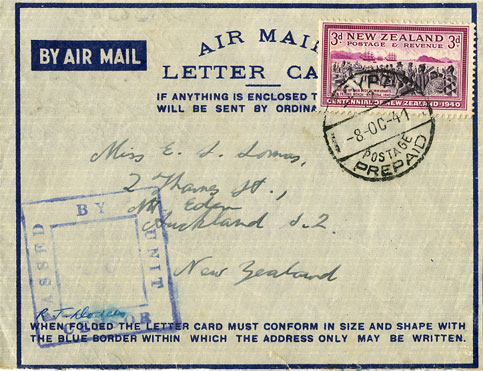
Air Mail Letter Cards were introduced in March 1941 for mail between forces in the Middle East and the UK. They were much lighter than ordinary air mail letters. From 5 July 1941, they became available for mail between the Middle East and New Zealand. The postage rate was 3d and was payable in New Zealand stamps [2].
This letter card is postmarked Egypt 42 Postage Prepaid on 8 October 1941. It may have been flown from Cairo on NE 128 on 12 October arriving in Sydney on 21 October or, more likely, to Singapore by KLM.

As the paper was very thin, it had an overlay so that it could not be read from the other
side.
The early letter cards, like this one, had a tartan overlay as shown.
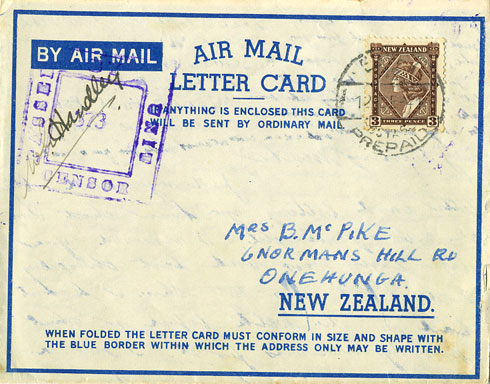
Reserve Horseshoe Route
The font of Air Mail Letter Card is different in this next card and it is in a lighter shade of blue. The overlay is also different and is composed of thin stripes.

Cards produced specially for the New Zealand forces had New Zealand already printed in the address panel as shown in this example.
The letter in the card is dated 12 December 1941. That was after the attack on Pearl Harbor and due to Japanese advances, the Horseshoe Route was changed.
Three reserve routes were set up to avoid Bangkok. After 8 December, the Reserve Route 2 went from Rangoon via Port Blair in the Andaman Islands in the Bay of Bengal to Penang [1].
This letter presumably went by Route 2 or by KLM.
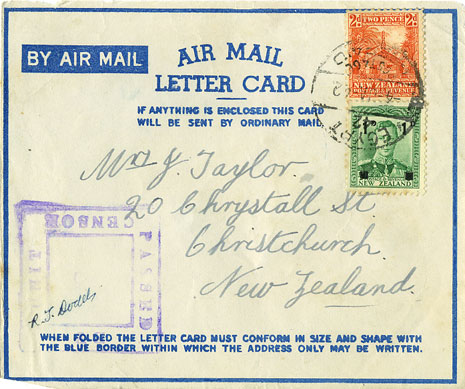
Route 3: avoiding Malaya
Route 3, in which Malaya was also avoided, was used after 30 December. This next card is postmarked Egypt 42 Postage Prepaid on 4 January 1942 and would go by Route 3 or by KLM.
The final dispatch of air mail from troops in Egypt to New Zealand via the Horseshoe Route was on 5 February and arrived in New Zealand on 25 February. It presumably went by NE 160.
From the middle of February, the Horseshoe Route only
operated between Durban and Calcutta.
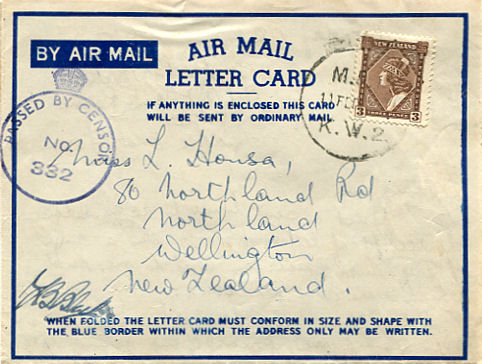
Missed last air mail 1942
This card is postmarked at KW 2 on 11 February 1942 and so missed the last dispatch on 5 February. It would therefore be sent by sea. According to contemporary New Zealand newspapers, this mail had not arrived by the end of March.
It was 24 February before New Zealand troops were told that the air mail service was no longer available.
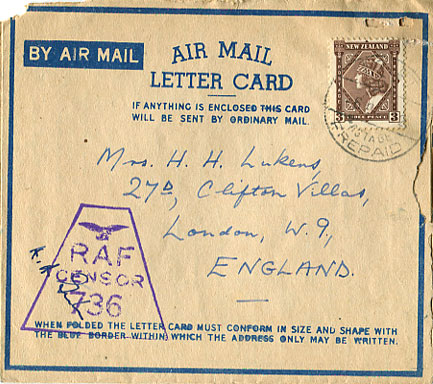
Mail to UK franked with NZ stamp, 1942
This air mail letter card is addressed to the UK and has an RAF / censor / 736 handstamp. However, it is franked with a New Zealand 3d stamp although it appears otherwise to have no connection with New Zealand.
This demonstrates that due to temporary shortage of stamps, the forces were allowed to use stamps from other allied countries.
The postmark is Egypt 6 Postage Prepaid on 6 October 1942.
The route from Egypt was by air to West Africa and then by sea to the UK.
From New Zealand
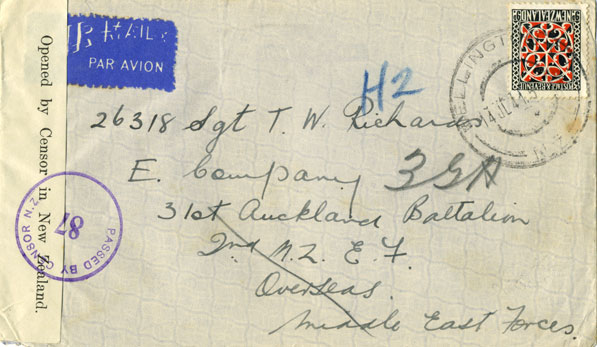
Air Mail Concession Rate of 9d
Until November 1940, airmail from New Zealand to NZ forces in the Middle East was charged at the full rate of 1s 6d. However, on 22 November 1940, an airmail concession rate to overseas forces of 9d was introduced [2].
This cover is from New Zealand to the Middle East Forces and is postmarked in Wellington on 14 July 1941 where it was opened by the censor. It is franked at the concession rate of 9d.
The address is to the Battalion and this has been changed in manuscript to 3GA. As army units were moved around, it would be normal for further address information to be added by the army postal authorities in Egypt.
The concession rate was for a maximum of a ½ oz.
If the letter weighed more than that then the normal rate of 1s 6d per ½ oz
applied [2] and so would cost at least 3s.
Air Mail only between New Zealand and Australia, February 1942
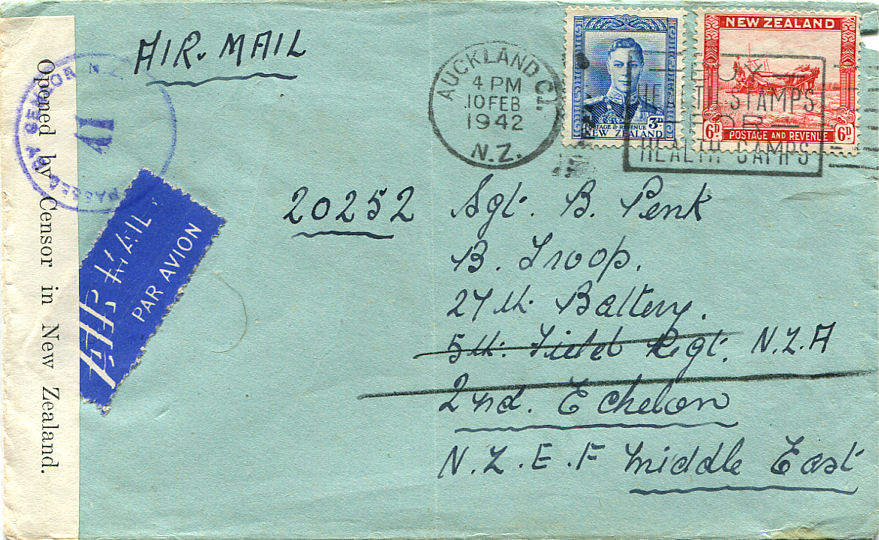
To NZEF
With the break in the Horseshoe Route, there was no longer an airmail service between New Zealand and their forces in the Middle East. From 6 February 1942, the 9d concessionary rate was therefore withdrawn.
Although this cover is postmarked in New Zealand on 10 February 1942, it is still franked with 9d.
It would be sent by air from New Zealand to Australia (and perhaps by internal Australian air mail) but it would then go on by surface.
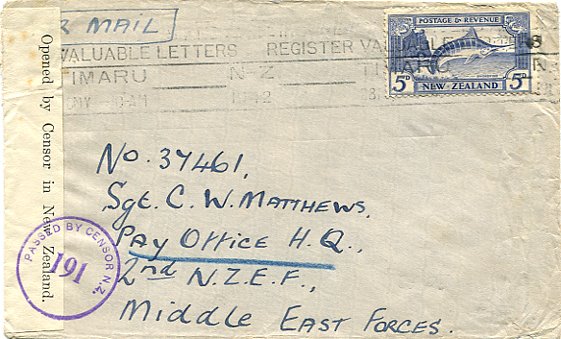
As mail for the NZEF was now only being sent by air to Australia, the new rate was 5d.
This cover addressed to the NZEF in the Middle East is postmarked in Timaru on 6 May 1942 and was censored in Christchurch [8].
It is franked with 5d and so would have been flown to
Australia and then sent on by sea.
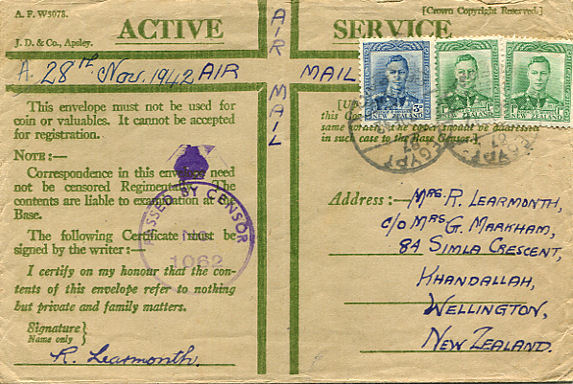
From NZEF
Whereas mail from New Zealand to overseas forces was reduced to 5d in February 1942, it was 5 June 1942 before the air mail rate was reduced from 9d to 5d for air mail from the forces in the Middle East to New Zealand.
This Honour envelope is postmarked in Egypt on 7 December 1942 while the manuscript on the front indicates that it was written on 28 November. The postmark is Egypt 87 Postage Prepaid.
As it would be sent to Australia by surface and only flown to New Zealand from there, the postal rate was only 5d.
Apparently, the mail was often not flown within Australia or indeed went all the
way to New Zealand by surface mail and so the air mail rate was further reduced to 3d
on 12 July 1943 [2].
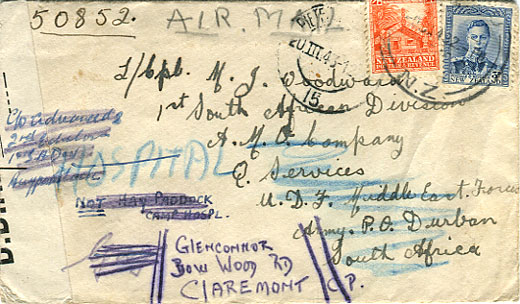
To South Africa
This much redirected air mail cover, franked with 5d, is addressed to a soldier in South Africa and was postmarked in New Zealand on 9 January 1943.
Again it would have been flown to Australia before being sent on by sea.
It has a South African transit mark 70 days later on 20 March
along with a series of redirections once it arrived in South Africa.
It is not clear about which of the re-directions resulted in the transit mark.
To Malta

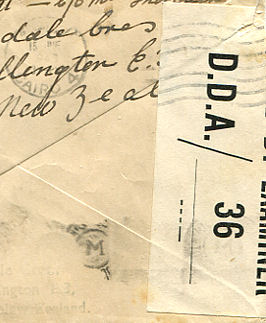
This cover is addressed to Malta and after being flown to Australia would have first gone to Egypt by sea and from there by sea to Malta.
It is postmarked in New Zealand on 12 May 1943 and has an Egyptian censor
mark on the front and a Cairo transit mark on 15 June.
From Syria to UK with NZ stamps

The postmark on this cover is rather indistinct, but appears to be 2 April 1942 at Field Post Office 567 which was in Syria. That ties with the date as from February to June 1942, the New Zealand forces had been withdrawn to Syria.
The cover is franked with 10d in New Zealand stamps and is addressed to the UK. It would therefore be flown from Egypt to West Africa and then complete its journey to the UK by sea.
It has O.A.S. in manuscript which stands for On Active Service and is passed by Censor No 633.
As troops shared the Field Post Office and could use the stamps
of other nations, it was not necessarily sent by a New Zealand soldier,
but the presence of New Zealand troops would be why the Field Post Office
had New Zealand stamps.
From Italy to UK with NZ stamps
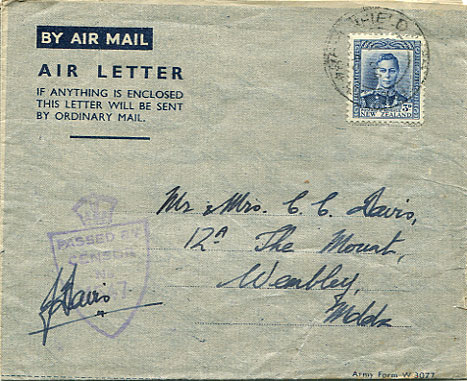
This air letter, with shield censor 4547, was sent from Italy to the UK in January 1945 and is franked with a 3d KGVI New Zealand stamp.
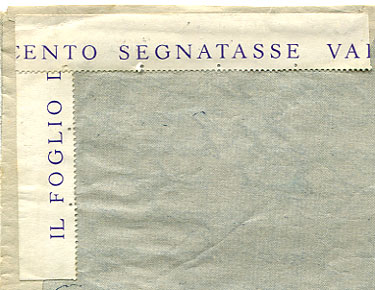
As with the earlier cover from Syria, the sender seems to have no connection with New Zealand and so is another example of how senders were not restricted to using stamps from their own country.
The Field Post Office postmark is indistinct, but looks like 684. The letter is dated 4 January 1945 and he refers to having received a letter from the UK that had been sent on 26 December. Airmail from Italy to the UK went via Gibralter.
His unit is No 1, A.R.R., C.M.F.. The last three letters stand for Central Mediterranean Force which was in Italy from 1943 to 1945 and was a combination of the M.E.F.(Middle East Forces) and the B.N.A.F. (British North Africa Forces).
It has been sealed on the back with tape written in Italian.
Segnatasse means postage due, but its significance is not clear.
All scans were made by the author.
Information is taken from
The Postage Stamps of New Zealand Vol 3,
published by the
Royal Philatelic Society of New Zealand in 1955.
[1] Bridging the Continents in Wartime: Important Airmail Routes 1939-45,
H. E. Aitink and E. Hovenkamp, SLTW, Enschede, 2005.
[2] Airmails of New Zealand, volume 3, R.M.
Startup, 1997,
Air Mail Society of New Zealand
[3] Postmarks used by Base Post Offices in the Middle East,
E.W. Leppard, The Kiwi, vol 41, no.1, pp 12-15, January 1992.
[4] Lustre Force - The New Zealand Army Post Office in Greece,
R.M. Startup, The Mail Coach, vol 12, no.3, November 1975.
[5] Used Abroad - Middle East,
R.M. Startup, The Mail Coach, vol 23, no.2, pp 49 - 63, December 1986.
[6] Green Envelopes 1940-1945,
R.M. Startup, The Mail Coach, vol 14, no.5, pp 112 - 117, January 1978.
[7] Postmarked Egypt,
The Mail Coach, vol 20, no.2, pp 49-53, December 1983.
[8] The Postal History of World War II Mail between New
Zealand and Switzerland, R.M. Startup and C.J. LaBlonde, 2005.